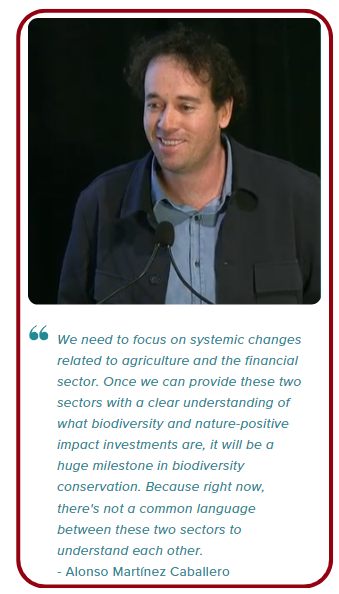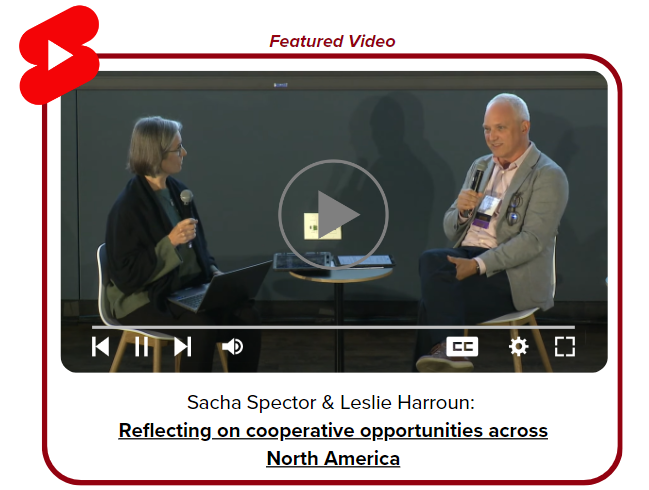The Salazar Center’s fifth International Symposium on Conservation Impact focused on how to achieve a nature-positive future together, to catapult our communities towards durable, high-impact outcomes for climate, biodiversity, and human well-being.
We brought together diverse thought leaders to share ideas and best practices for moving beyond individual pilot projects to build lasting systems change for nature and communities across North America. Our two-day dialogue elevated the interconnectedness of biodiversity loss and climate change, both in terms of their impacts and solutions, while highlighting how a nature-based approach can enhance the resilience of both our planet and society. By design, we assembled speakers with varied expertise and backgrounds to showcase the breadth of differing, and sometimes contrarian, opinions and ideas related to our theme. Our intent with this approach was to facilitate our attendees’ ability to deepen their understanding of the issues and perhaps challenge their perspectives.
The 2023 Symposium Synthesis Report summarizes five cross-cutting themes that emerged from the Symposium, as well as key takeaways from each session. The themes reflect ideas, needs, and opportunities raised multiple times by speakers or attendees. Like the interconnectedness of biodiversity and climate, each theme is also connected to the next. Together, they help illuminate potential shared pathways to enrich biodiversity and build long-term, stable societies and healthy economies across North America.
Don’t have time to read the full report? No problem! We’ve broken it down so you can focus on what resonates the most right now.
Cross-cutting Theme: Systems Change
“Nature-positive, carbon-negative, justice-forward.” – Sacha Spector
As a community of practice, our end goal should be a “nature-positive, carbon-negative, justice-forward” society. To achieve this, we need to break out of our silos and broaden our project-scale thinking to reimagine and redesign the underlying relationships between nature, climate, and community. We must address the root causes of biodiversity loss and climate change rather than merely reacting to them.
Throughout the Symposium, speakers articulated the need for ‘multi-solving.’ In other words, we must recognize the interconnected drivers behind biodiversity loss and climate change and seek to implement policies and projects with the potential to address multiple threats across the climate-nature-equity space when possible. There is sufficient evidence that nature can mitigate and sometimes reverse climate impacts while providing social, economic, and ecological co-benefits. Nature underpins our economy and well-being in North America. For example, data shows that nature-based solutions (NBS) can cost-effectively provide 37% of the CO2 mitigation we need by 2030 to give us a meaningful chance of holding warming to below two degrees Celsius. Similarly, nature-based solutions are critical to reversing biodiversity decline. By focusing on implementing solutions that address multiple challenges, we drive the changes necessary to foster durable, positive systems change.
Wicked problems require interdisciplinary solutions
 Tied to the theme of ‘multi-solving,’ Symposium participants unequivocally called for ‘mainstreaming’ biodiversity and NBS in all planning, implementation, and policy processes. While we’ve seen unprecedented progress within our conservation community and natural resource agencies to implement nature-based solutions, mainstreaming the protection and regeneration of biodiversity will require incorporating nature-based solutions into the planning, management, and policies of all sectors and agencies. As noted by many speakers, success will come only when climate change and nature are embraced within a whole-of-government approach to solving this twin crisis.
Tied to the theme of ‘multi-solving,’ Symposium participants unequivocally called for ‘mainstreaming’ biodiversity and NBS in all planning, implementation, and policy processes. While we’ve seen unprecedented progress within our conservation community and natural resource agencies to implement nature-based solutions, mainstreaming the protection and regeneration of biodiversity will require incorporating nature-based solutions into the planning, management, and policies of all sectors and agencies. As noted by many speakers, success will come only when climate change and nature are embraced within a whole-of-government approach to solving this twin crisis.
This idea was similarly elevated for non-government sectors. To create transformative change, we need to enable lasting solutions to our climate and biodiversity crises. All sectors need to treat climate and biodiversity as foundational to their operations and supply chains. We must break down the various silos limiting our ability to evolve and enable lasting solutions. This requires reaching beyond the traditional conservation community and thinking deeply about other segments of society, including the business, banking, and finance sectors, agriculture, energy, and rural and urban communities.
A related theme resonated across our two-day dialogue as vital to systems change: the importance of keeping people and communities at the center of the work. Speakers acknowledged that progress has been made to weave equity into federal policy, conservation practice, and corporate efforts while recognizing that we have not yet fully institutionalized equity and community co-benefits into our government, conservation, and corporate systems. To succeed in the long run, Indigenous and frontline communities must have the agency to co-create solutions and ensure that benefits are equitably shared. They must become integral to the development of practices, policies, and institutions to advance positive climate and biodiversity outcomes. No longer can solutions come at the expense of the livelihoods and well-being of marginalized communities. To achieve this, we need to consider how we break down and re-assemble the systems that kept so many communities out of the conversation in the first place.

